Content Warnings
Lolicon references, Mental illness, MurderOUT OF TOUCH
The Twitter account “Out of Touch Thursdays” has posted the same clip from the Lucky Star anime opening with Hall and Oates “Out of Touch” played over it for over two years now. Does it work? Well, kind of. It’s a bit like the old gif of “Dancing Spider-Man”, in which we’re likely to notice the parts that synchronise more than the parts that don’t. I don’t follow it, and not just because timezones means I never actually see it on a Thursday, but because I don’t have to. It will just appear in my feed like a random encounter in an RPG, twenty-seven seconds I will almost always see to the end. Why? I’m not alone in this. Nearly 60 thousand people follow @ootthursday. That’s not including the clones that exist due to people’s political disagreements with a Twitter gimmick account. There’s even a synthwave remix, surely the high watermark of an oversaturated meme. But why this song? Why this anime?
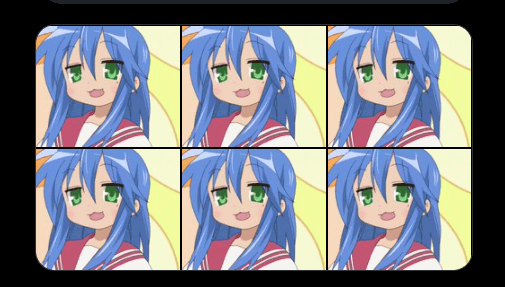
Lucky Star is… old now. The manga started in 2003 and has continued off and on ever since, but it’s the 2007 anime adaptation that’s far more well known. The self-proclaimed saviour of anime and full-time Twitter dumbass Yutaka Yamamoto (Yamakan) directed the first four episodes. The far more talented, stable and regrettably no longer with us, Yasuhiro Takemoto replaced him for the remainder of its two-cours run. I’ll admit now that it’s far from my favourite anime. It’s not even my favourite slice of life anime made by Kyoto Animation. K-On may have doubled down on the saccharine moe, but the musical theme and likeable cast make it more enjoyable if disposable watch. Nichijou is much funnier and better animated, and it is probably my favourite KyoAni production period. But neither of these things were Lucky Star’s main appeal. Even in 2007, there were dozens of shows like it, but none of those had Konata. With her long blue hair, piercing green eyes and Aya Hirano voice, she was always destined to be the main character in the ensemble.
She’s also an otaku.
Pandering to the otaku demographic was nothing new. Gainax built their empire on “by otaku, for otaku”, and it didn’t take long for mecha anime to realise there was more money in courting the manchildren than the actual children. What changed was what the otaku wanted. Evangelion shifted the focus of otaku merchandising from robot kits to character goods, and so did the anime landscape shift as a whole from seas of giant robots to escapist high-school fantasies. Not a sudden sea change, mind. There were still many mecha anime around this time, even shows that saw mainstream success like Macross Frontier, Code Geass and of course, Tengen Toppa Gurren Lagann. These shows all emphasised their character designs, which is no coincidence. They were part of the inevitable attempts to bridge the gap between otaku markets to varying degrees of success. They were approaching this problem from the mecha side of things. KyoAni, several years after their contributions to the Full Metal Panic franchise and with multiple moe centric light and visual novel adaptations under their belt, were perfectly poised to attack from the other direction.

Konata Izumi was not just an otaku, she was THE otaku, and she was cute to boot. You may as well have created her in a lab for maximum nerd appeal. Considering this was the time of EPIC GAMER WEBCOMICS, there was a demand for “she likes the same things I like”, and endless light novel adaptations weren’t yet serving that. She isn’t the love interest of an obvious self insert main character, but that in turn benefits the purity obsessed otaku crowd, as does the primarily absent male cast. She and her female friends trade in-joke references as they debate the correct way to eat a chocolate cornet. Each episode ends with a karaoke rendition of a popular anime song, or at least a thinly veiled parody.
Unfortunately, pandering to otaku includes the skeevier end of the spectrum. While Lucky Star blissfully avoids overtly sexualising its cast of young girls, it doesn’t forget to make Konata’s father a comical paedophile or have Konata herself play adult dating games. I won’t and can’t begrudge anyone who enjoys Lucky Star as even my beloved Azumanga has a creepy teacher who leers and pants at the girls in the swimming pool. The inclusion of these elements is more an indictment of the society that produced them, and neither are close to the worst offenders. That its most emotional episode comes with the revelation that Konata’s mother was so desired for her loli body type is probably best not to think about.
Perhaps it’s no wonder that when we cast our minds back to past media, especially ones we enjoyed at formative ages, they do not appear fully formed, carrying all of their baggage. We remember the ghost of Lucky Star, so representative of what it meant to be an anime fan at that time. What was contemporary fan service is now a time capsule. Before legal streaming and simulcasts, before anime was something Netflix would spend millions remaking into live-action, when anime was kind of, well, cringeworthy. Maybe that’s why more problematic elements stand out these days. At the time, you had to take the embarrassment as par for the course, even a badge of honour that you could take it, unlike the normies. Lucky Star is a bit cringe. When I see that 27-second clip, I can picture teens practising dance moves in a dimly lit mirror. A guy I knew in high school who thought “timotei” was the funniest thing in the world and so would say it all the time like some kind of in-person mic spam. I still remember buying Ouran Highschool Host Club from an HMV and hiding it from my parents out of embarrassment. They thought I’d bought porn. I suppose they were relieved to see the pink box and handsome boys in uniform, but they were Catholics, so maybe not. I still get flashbacks to sharing Sailor Moon lyrics on Facebook. To be a teenager is to be uncool in some sense, but anime was even further down the totem pole than videogames. I made some of my best friends from an anime club I created, but I met just as many poster defacements and overall embarrassment.
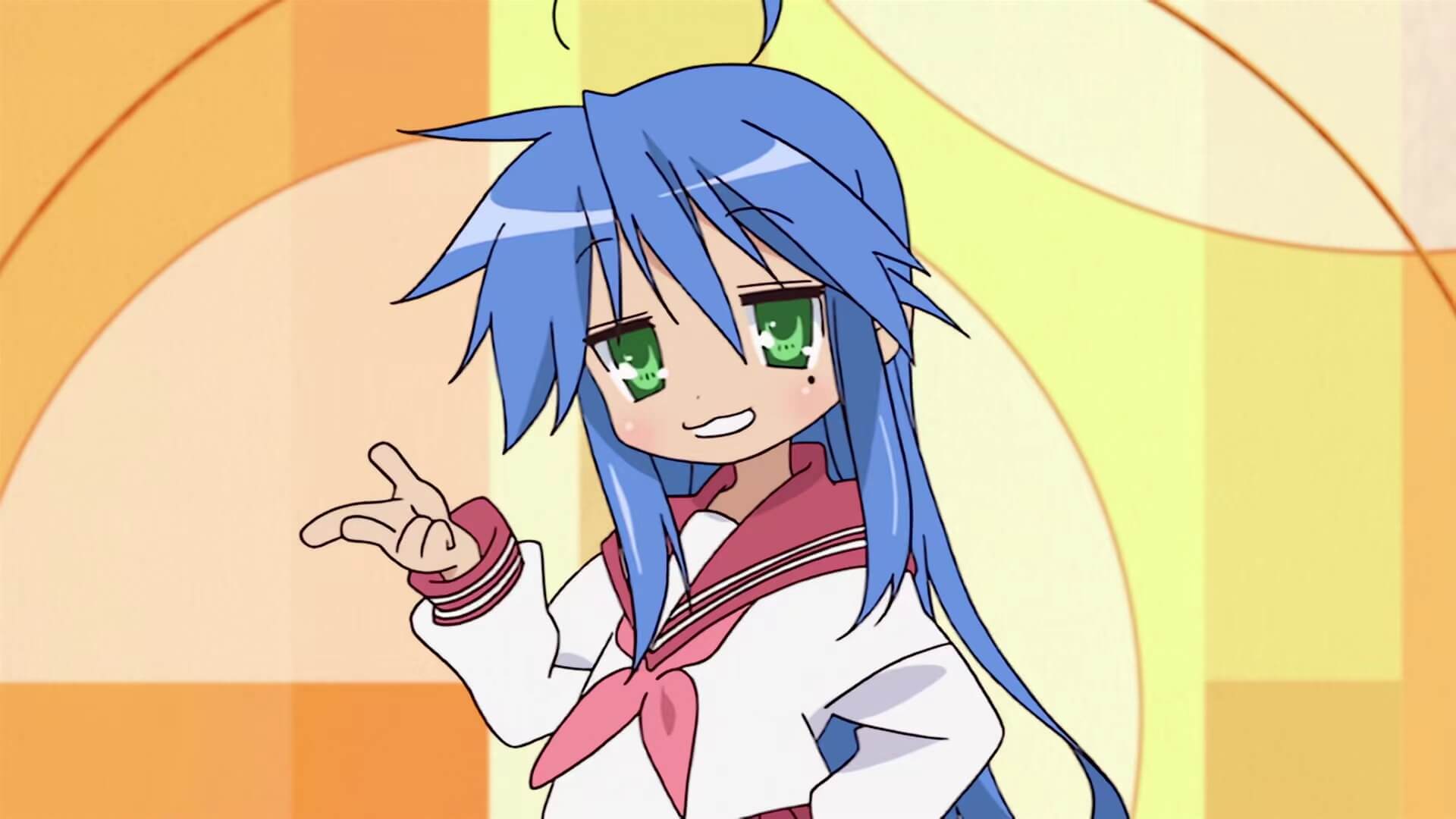
But then. The music. “Motteke! Sailor Fuku”, the actual opening theme, is the sugarcoated earworm you’d expect in a show like Lucky Star, and perhaps the peak of what we can consider cringe-worthy. It has nonsense lyrics about school skirt lengths, Zettai Ryouiki (referring to the visible bit of skin above knee socks, for some reason taking its name from Evangelion) and ancient tales of blind Buddhist monks, all sung by the voice cast. There are far worse examples of its type, but it isn’t memorable either. It’s not particularly surprising that in modern memery, it’d be replaced.
Out of Touch. One of Hall and Oates (if Wikipedia is allowed to call them that so am I) six number one singles. Like Lucky Star, I’m not a fan. They’re a duo whose work I was passingly familiar with through radio play and movie montages. Out of Touch does stand out with its new-wave synth arpeggios (reportedly conceived by John Oates while stoned and messing around with a Roland Synthesizer) and hear-it-once-and-it-will-never-leave chorus. How much I’d enjoy hearing it for the first time, I can’t possibly imagine—hearing it at least once a week has chipped away any resistance, like some kind of musical Stockholm syndrome. The passing of time has changed the song’s message from a somewhat cryptic series of metaphors about a relationship on the rocks to a mournful anthem of nostalgia. The song itself is out of touch and out of time with the culture we view it from. Astrophysics’ synthwave remix demonstrates this well- synthwave is a genre that evokes a cinematic 80s, an aesthetic of blinding neon and hyper-violence. It riffs on the likes of John Carpenter scores but with modern production sensibilities. You can hear the original 80s instrumental buried underneath the neo-80s one, struggling for air. I don’t want to rag on the production of a bonus track on a random Bandcamp album too much; it’s hardly the only example of the cultural ouroboros of the music industry.
For the 20th anniversary of Kaoru Akimoto’s city pop banger Cologne, we were treated to a pretty excellent remastering of the album and a remix EP from future funk artist Night Tempo. Almost every future funk song samples from city pop/anime/videogames/all the above, sharing the plunderphonics sensibilities of its elder cousin, vaporwave. An official remix is a bit different. Night Tempo describes himself as a “retro culture curator”, and I don’t exactly disagree. I was fortunate enough to see him do a set in Shibuya in 2019, alongside several other future funk artists. I was only really familiar with Macross 82-99 before the show, whose SAILORWAVE records, bangers that they are, probably contributed a lot to the sad aesthetic version of Sailor Moon I brought up in “SAD GIRLS”. It was a fun night and an excellent way to ring in the new year (it was that or freeze at the Shibuya crosswalk), but it was a celebration of “retro culture”, not “80s culture”. Anime girls with bright coloured fluffy hair, dancing to snapshots of a time most hearing it never experienced. I have no way to know the thought process behind the original pairing. The meme doesn’t originate on Twitter, having taken a convoluted journey from Tumblr to YouTube to Twitter posts to Twitter gimmick account. But those 27 seconds create a concoction, accidentally or not, of both retro faux-nostalgia for synth-pop mediated through modern music trends and a legitimate nostalgia for a titan of the anime landscape.

Before, I mentioned that I’m not a big fan of Lucky Star. That was true at the time, too. I wasn’t exactly a person of discerning taste. It just didn’t grab me like other (sometimes worse!) series did back then. I only watched Lucky Star because it came from a studio whose work I was already familiar with. Another tremendously popular show, but one that’s had far less of a cultural half-life.
One about aliens, time-travellers and espers.

OUT OF TIME
The Melancholy of Haruhi Suzumiya, like Lucky Star, is technically still going. The most recent novel came out in November 2020, and Satelight (not KyoAni) released a spin-off anime in 2015. I was vaguely familiar with the latter, but not with the former. You’d think the return of the reality-warping god queen of Japanese pop culture would have had more impact after nine years of absence, but the truth is she’d tumbled down the memory hole far before then. How did that happen? Sure, fads come and go, but this show inspired a real-life version of the SOS Brigade and even a fake religion. You’d think there’d at least be more nostalgia for it.
We should rewind a little. What is Haruhi, exactly? Despite sharing the high school setting of Lucky Star, the premise is a fair bit more complicated. Our narrator and main character, Kyon, is an ordinary high-school student with a sarcastic sense of humour- no, wait, come back! It’s not that bad! Well, ok, it’s a bit bad. The show’s characters are rarely more than a collection of basic tropes with “-dere” suffixes, but Kyon’s drywall dullness is at least purposeful. His classmate Haruhi is not merely an eccentric, but some kind of God-like being who can influence reality around her. She wants to find aliens, time-travellers and espers, so naturally, she draws them to her. She may have even conjured them from thin air. Kyon is the only average human in whom Haruhi shows any interest, leading the supernatural members of Haruhi’s “Spreading excitement all Over the World with Haruhi Suzumiya Brigade” (S.O.S) to conclude that Kyon may be more significant than he realises. Kyon is their confidant, with Haruhi herself having no idea that the extraordinary people she seeks are incredibly close by. If she was to know that, she might have more of an inkling of her powers, which could be disastrous for the fabric of reality. If that seems a convoluted premise, then, well, yeah, it is. But it is also a fairly typical high school comedy. This eclectic mix of genres, plus Kyoto Animation’s proven talent for adaptation, were a sure-fire recipe for success.
And succeed it did. It felt like Haruhi’s in-universe powers mirrored the show’s popularity in the real world. Lucky Star did well, but Haruhi was more of the zeitgeist, a defining moment in otaku culture, particularly in the West. As Hazel brings up in her excellent overview of Elfen Lied , the limited availability of officially released anime meant that to be an anime fan was to be a fan of all anime available to you. You can see this phenomenon play out across time and scale, from the monoculture of pre-VHS TV and pre-internet popular music to every console early adopter pushing themselves through a Lair, Ryse, or Steel Diver to justify their shiny new purchase. You would struggle to find much outside the usual shonen heavy hitters in a non-speciality shop. These shows constitute what I christen “HMV-core”- Ouran, Evangelion movies (rarely that oft coveted tin of the series), Stand Alone Complex, Darker than Black, and yes, Haruhi. You could torrent or stream (either on sketchy websites or in a million parts on YouTube), but even if you weren’t buying the official DVDs, those officially licensed series (and therefore dubbed) were always the most popular. This is still somewhat true today, but the line is blurred by simulcasting, and the sheer size of the international anime industry makes it impossible to keep up with everything. This isn’t a bad thing, since at least it doesn’t mean that somehow everyone and their mother would end up watching garbage like Chobits, but it did allow for a different sense of community than exists nowadays. It also allowed for an eco-system where “flavour of the month” shows could stick around much longer. Is why we don’t talk about Haruhi anymore?

To get that list of “HMV-core” anime, I surveyed a few different people. I asked them a simple question: What series do you imagine on the shelves in the mid to late 00s and early 10s? I got a lot of great answers. Origin: Spirits of the Past and Paprika came up several times, which, if we extrapolate, means a 1:1 ratio of bad to fantastic in the anime film department. None of them said Haruhi.
Truly this is the Disappearance of Haruhi Suzumiya.
The question wasn’t supposed to prove my thesis, just add a bit of flavour, but here we are. The truth is it doesn’t seem there’s any one reason for it to have left the collective consciousness. It’s more like a death by a thousand cuts. Some of these cuts were out of the franchises’ control. That doesn’t mean the show is off the hook here. Let’s start with why I lost interest- the plot, or lack thereof. If Haruhi were to come out now, in the landscape of a billion isekai shows, light novel adaptations and isekai light novel adaptations, I would probably have the correct set of expectations. Light novels are, in theory, a space to do anime things in weirder or more specific ways. Whether it’s Dirty Pair’s combination of pulp sci-fi and women’s wrestling or Spice and Wolf’s enchanting fantasy world with painfully detailed economics, neither would have been greenlit as an anime. They’re a much safer bet once proven successful as a light novel. These are, unfortunately, the exception rather than the rule.
Yamakan, who when we last left him had been fired from Lucky Star, got in hot water a couple of years back for his adaptation of the brilliantly titled “[New Life+] Young Again in Another World”. If you didn’t hear about this series, that’s because it didn’t come out. It turned out the author had said some unprintable things about Chinese and Korean people on his Twitter. And by “it turned out”, I mean “should have come as no surprise”, considering that the "original light novels center on a Japanese protagonist who killed more than 3,000 people with a Japanese sword in the Second Sino-Japanese War… After living to the age of 94, and killing another 2,000 people through the course of his life, the character gets reborn as an 18-year-old man in another world." The show got cancelled, though this was after nearly twenty volumes of the light novel had shipped, so I’m not going to give out any gold stars. Yamakan managed to worsen the situation by doing the classic “what if both sides” schtick because I didn’t call him a professional Twitter dumbass for nothing. His original account remains suspended to this day. Behold the true legacy of the light novel, horniness, wish-fulfilment and weird nationalism, perhaps unsurprising coming from a field dominated by more young dudes than any other. We should be so lucky that Haruhi only indulges in the first two of those tropes. I should never have expected the sci-fi and fantasy elements to ever become the focus, aside from teases at the end of arcs. If we check on the later volumes, that’s still the case. They’re still in school, and they’re still in a club, with the same cast (plus one extra from another timeline), and aside from a confrontation in the penultimate (as of writing) volume, the stakes have not risen. If Mikuru’s moe-appeal and uh, “ample charms” are enough to carry it for you, then the narrative is working as intended. Haruhi Suzumiya’s god powers play second fiddle to her role as a magic pixie dream girl for Kyon. “Will they, won’t they” isn’t exactly the question here- romantic tension might fly on network TV, but we’re talking about otaku here. Even bland self-insert Kyon isn’t as faceless as a dating sim protagonist. Therefore if they were to hook up, Haruhi’s perceived purity would be ruined. The otaku would despair, the door to their waifu’s heart forever shut.
If that seems a bit of a reach, you might not have heard what happened to Aya Hirano, Konata and Haruhi’s voice actress. After she committed the heinous crime of “implying she had a sex life on a variety TV show”, her otaku fanbase lost their collective shit. They destroyed Aya and Haruhi themed merchandise in displays not dissimilar to conservatives burning Nike shoes after the Colin Kaepernick ad campaign. It only got worse when photos of her affairs with bandmates leaked to the press. Aya wasn’t allowed to have Twitter followers even before this, and after fully retreated from social media, allowing a team to take over and presumably deal with the onslaught of very normal comments from very normal people. It’s not surprising that her number of voice acting roles decreased and that they’d be primarily supporting. I can only speculate, but I think it goes some way to explaining why we didn’t see an official follow up post Disappearance.
Haruhi still had legitimately interesting sci-fi concepts in defence of my past self. While somewhat bland personality-wise, Yuki Nagato is an intriguing take on an alien being. Created the Data Overmind, which may or may not be the galactic version of Japan’s LDP, she is a Humanoid Interface designed to influence and observe meatspace. One of several, in fact, each with different set parameters. While this is no doubt something of an excuse to have a Rei-type character, most would not even bother, so I’ll give credit where it’s due. Itsuki, our esper, and Mikuru, our time-traveller, fare less well, but that’s mainly since the threats inadvertently conjured by Haruhi are most often things Yuki can deal with directly. Memorably, when Haruhi creates the SOS Brigade’s distinctive logo, she accidentally draws the attention of an ancient data organism that had been roaming the earth for millions of years, unable to interface with anything until the invention of the computer. Itsuki… helps, but this is a job for the living computer alien. Apologies if your eyes glazed over there, but that’s the kind of oddball plotting that drew me to the series in the first place. After I finished the first series, I hoped the second would have more of that kind of thing, less goofy classroom antics.
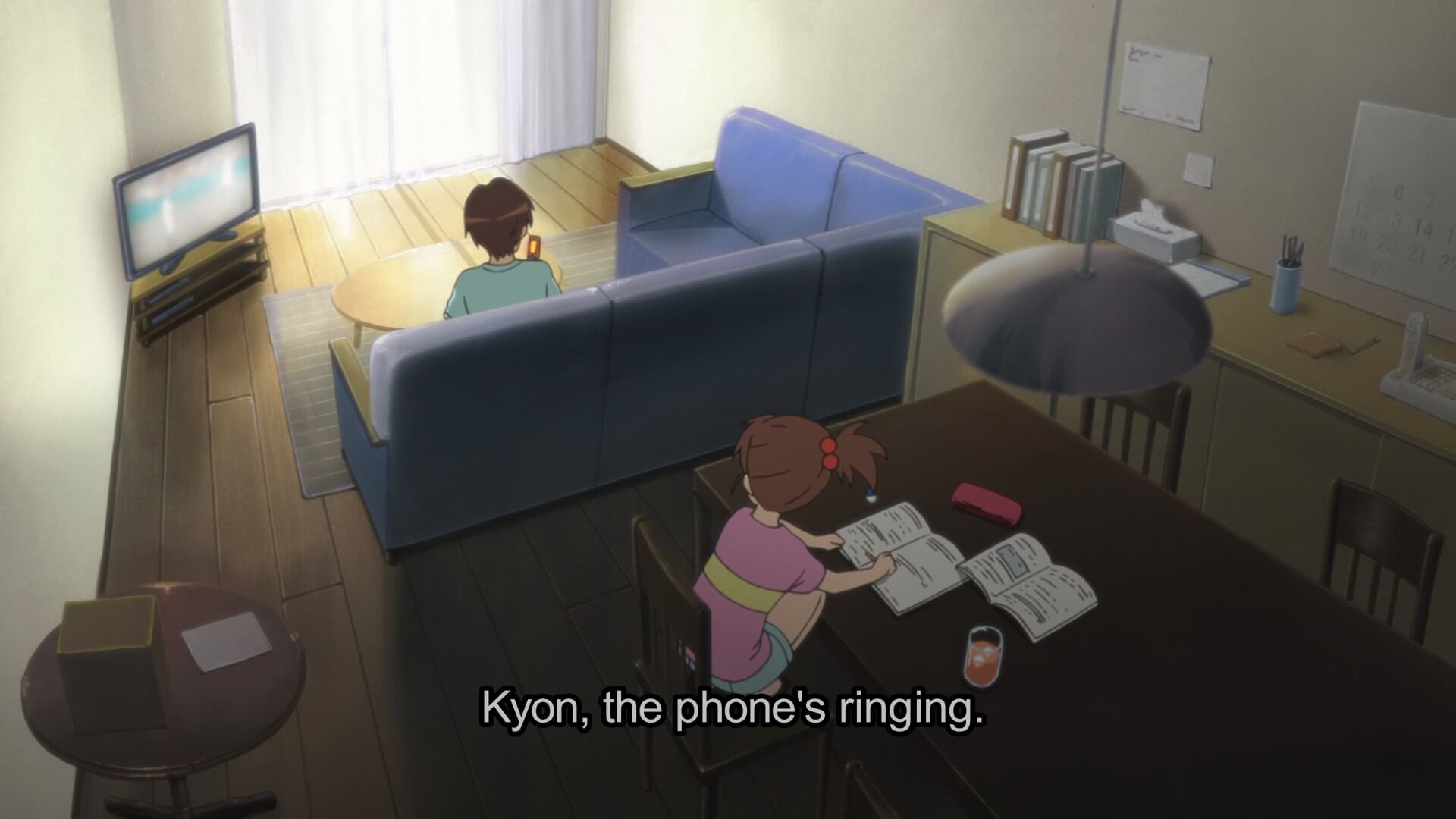
Well. I got what I wanted.
The much-maligned Endless Eight, which depicts a time loop by showing the same episodes with minor differences in character clothes and line delivery, was the first knock to the franchise’s reputation. Coming amid the second season, mixed in with 2009’s airing of the original episodes, it took up most of what was “new” in this new season. To say this decision proved unpopular would be a massive understatement. It inflated a short story from the fifth volume into a test of patience, comparable only to the most egregious of Dragon Ball filler. Too clever by half and not that engaging to watch, enduring Endless Eight became either a badge of honour or symbol of your mental decline. Just be glad they didn’t show all 1500 or so loops.
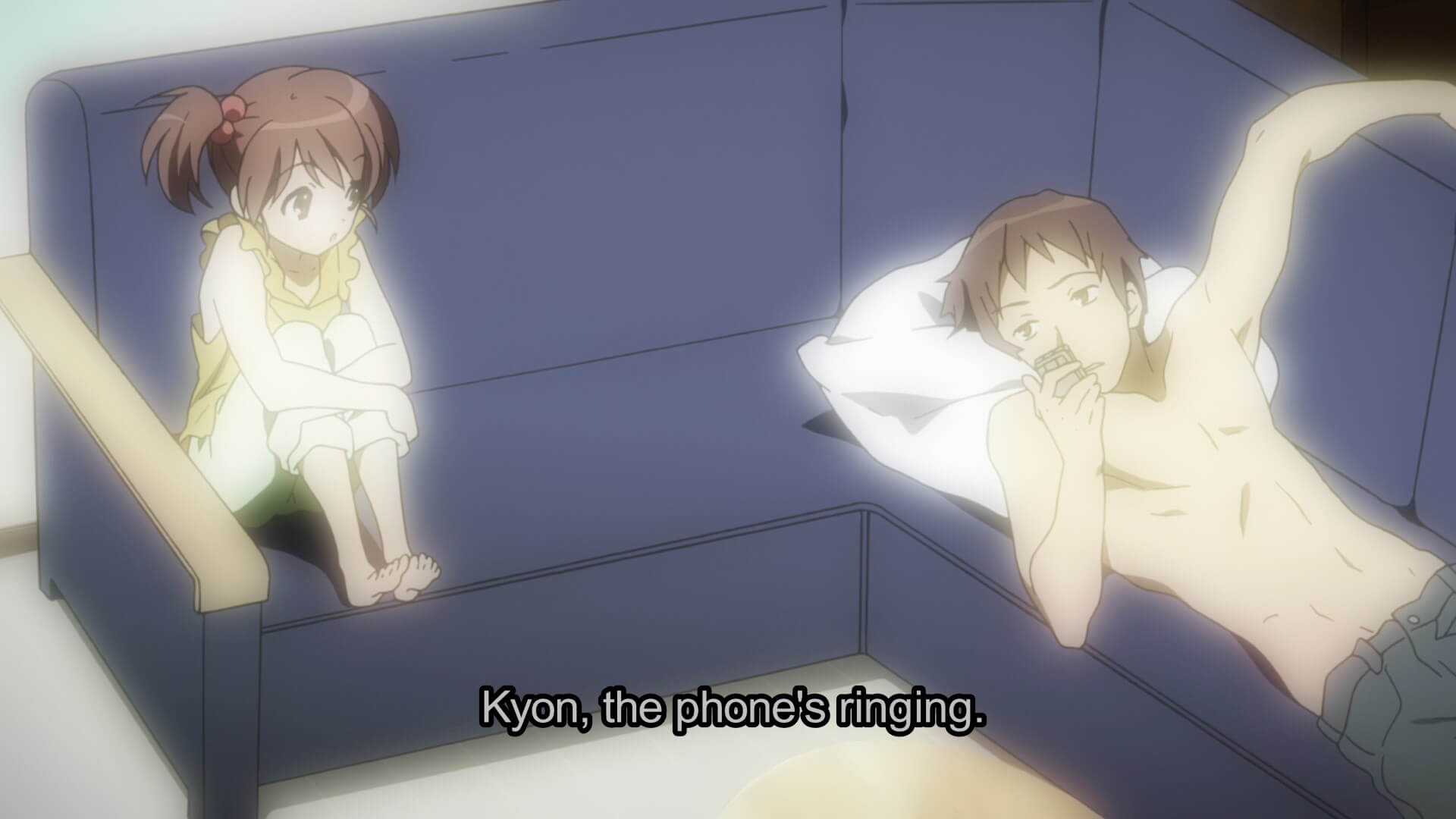
The much-maligned Endless Eight, a time loop shown through eight episodes with few differences in vocal lines and character clothing, dealt the first blow to fan interest. In 2009’s rebroadcast of the first season, KyoAni inserted 14 new episodes (effectively comprising the second season) amongst the old, the infamous Endless Eight comprising over half the new material. It wasn’t well-received, to say the least. What was once a short segment from book five is now a dreadful slog, bringing Naruto’s least inspired additional arcs to mind. Unique? Sure. Interesting? No. To put yourself through it meant you were a real anime fan, or at least dumb enough to waste your time with hours of repetitious drivel. At least we only see eight loops, right?
Now imagine that dumb gimmick eight times, except my paragraph took twenty minutes to read. There’s an argument for it being secretly genius, and the effect would be less annoying viewed weekly. Hell, I was almost convinced. I planned to include it in a future edition of my F(R)ICTION series, and I still might. It isn’t exactly lazy, at least not on the part of the voice actors. The series was no stranger to odd gimmicks, having aired its initial season out of order until the aforementioned 2009 re-airing. It’s a minor miracle that even this didn’t stop the Haruhi Hype train. The Disappearance of Haruhi Suzumiya, a lavish (and long!) feature-length adaptation of the light novels’ fourth volume, is easily the franchise’s high point, though we didn’t know it was to be its swan song. It’s an enjoyable and surprisingly emotive sci-fi romp; perhaps a bit damning in retrospect that it barely features Haruhi. It primarily takes place in an alternate universe, and while providing interesting (and much needed!) character development for Yuki and Kyon, it’s a melancholy end to this animated incarnation. It seems somewhat unfair for a franchise to die after such a high note, but perhaps it’s better that way.
Yamakan does have one aspect of his legacy that isn’t purely embarrassing. He is in part responsible for Haruhi Suzumiya’s most famous elements- its ending theme and choreographed dance number. I’ve been unable to find confirmation of his involvement in Lucky Star’s similar opening dance. Still, it’s one of many parallels and direct references to Haruhi Suzumiya, even if he wasn’t directly involved. Konata shares Haruhi’s voice actress, Haruhi merchandise litters her room, she attends a concert where we hear the exact rendition of God Knows from the first season of Haruhi Suzumiya. She even dresses as her while working in a cosplay cafe. What was once crass cross-promotion is, well, still crass cross-promotion, but with the sting that what it’s referencing is the less talked about nowadays. Something that helps neither is the lack of availability- they languish alone on Funimation’s streaming service. A physical boxset of Lucky Star is easy enough to buy, except that it’ll only play on US DVD and BluRay players. Haruhi is not so lucky. Maybe we’re due a memetic pairing of the Hare Hare Yukai with another 80s pop hit that’ll rocket it back to relevancy. While writing this, PUBG Mobile revealed a cross-promotion with Haruhi Suzumiya. Presumably, they didn’t want to be left empty-handed after Fortnite’s incredibly bizarre Naruto skins. Who knows if the chorus of “WTF?” in the replies was the intent, but I doubt Mikuru ditching her beam for a sniper rifle will be enough to regain either’s cultural cache.
Teach the zoomers how to torrent. If not for these flawed shows, then for preserving ones that truly touch the heart. If what you love falls to irrelevance, its availability hangs in the balance. In a world all ruled over by memes of loving grace, the value of art is not dictated by its worth to you but by the amount of conversation it generates. When I didn’t have much money, I sold my precious tin of Neon Genesis Evangelion. From then until the abominable Netflix translation, there was no legal way to watch one of the most groundbreaking series of all time- but don’t worry, Rebuild was there. There is now a (pretty expensive!) new BluRay set, which one hopes is free of Khara’s subtitle meddling. That’s the treatment NGE gets. Despite animes increase in popularity, it still doesn’t have the relative stability of live-action media availability. It’s thankfully not as bleak as videogame preservation, as there are no changing systems to worry about, but it’s close. If there’s anything to take from these shows, it’s that legacy is fickle, not to be relied upon. Not everything gets a meme to keep it on life support. The rest fall. Out of time.
NOT AROUND
Kyoto Animation would continue to succeed, though its modern legacy is inextricable from tragedy. In July 2019, Kyoto Animation’s Studio 1 was set ablaze by a lone perpetrator, convinced that the staff had plagiarised his novels. Thirty-six died, a further thirty-four injured. The accusations were spurious, not that it matters. I will not dignify the murderer with a name. Among the dead was Yasuhiro Takemoto, the director of the majority of Lucky Star and The Disappearance of Haruhi Suzumiya. He was far from the only victim from the productions I’ve focused on here. Yamakan, for his part, had left Kyoto Animation years earlier but still attempted to crowdfund an edgy magical girl show (not enough of those!) based on the disaster. I will try to give him the benefit of the doubt, considering he lost friends in the fire, but I’m glad something this poor taste failed to launch. A better memorial to the victims is remembering their output, warts and all.
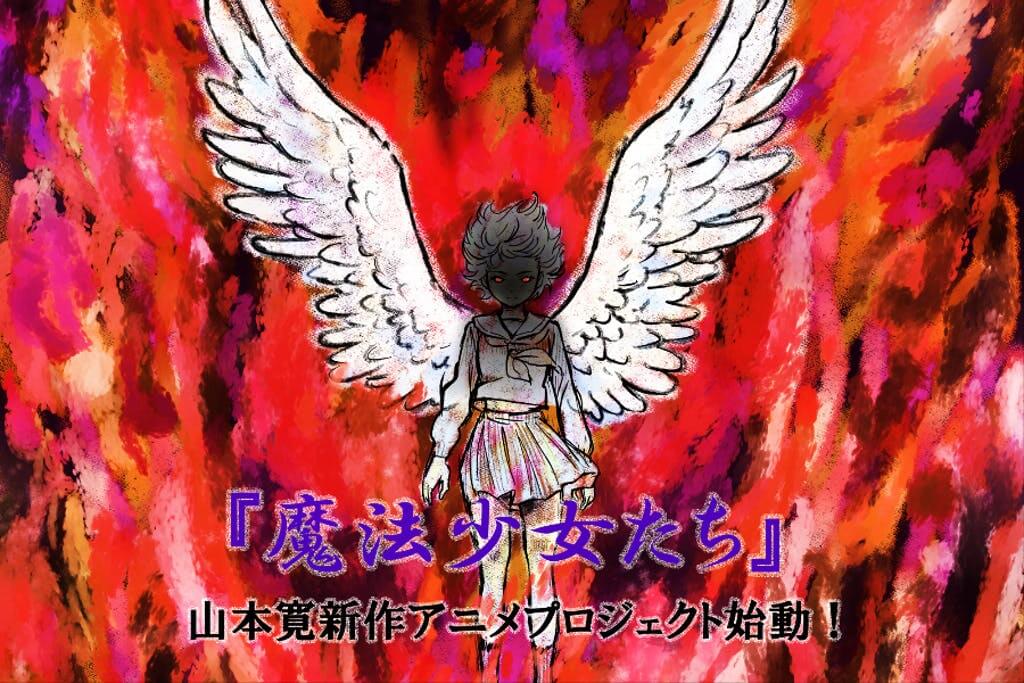
A meme can exist in a vacuum, but a work as a whole cannot. To engage with these past monuments of otaku culture is to grapple with the sickness deep within it. Being an anime fan does not put you at risk of becoming a mass murderer, but the culture that fails to care for its most broken, serving them only with further opportunities to consume, does. Perhaps even a perfect society would have its rotten eggs, but only a truly broken one incubates them. The perpetrators' known but vaguely defined “mental illness” and previous violent crime led only to a prior three and half year jail time. The invisible hand of the market will never provide genuine help. It can only sell solutions that are broken themselves, even when it appears to offer more than consumption. Whether it’s BetterHelp in the West or Japan’s horrifying hikidashi-ya, nothing provided by capital intends to save you. In considering these shows, I don’t want to harken back to some halcyon day in which anime and anime fandom was good. It is easy to mistake youth for innocence. Nor do I want to deny you the simple pleasure of nostalgia. It can be a potent drug.
In truth, I didn’t intend for this to become so serious. I wanted this article to be a lightweight examination of a weird Twitter phenomenon. Whether that’s a me problem or a media problem is irrelevant. Scratch even the most forgettable show, and its context and culture will come pouring out. Neither of these shows were meant to stand the test of time. Both act as time capsules and are part of a chain that leads to today’s industry. But I’d like to think that we can at least not be forever chasing the newest thing in this age of peak media consumption, that we can use the time afforded to us to engage with art that truly speaks to us, not just what’s talked about the most at that time. Or better yet, engage with the forces that produce such balming agents in the face of apocalypse. Art is important. It should be preserved, and where it came from should be remembered, no matter if it unearths something painful. Art can give us hope, comfort, anything denied to us by the world we live in- but I believe art will be better in a world that treats both its artists and patrons better. The story of Kyoto Animation is not a cautionary tale of courting a demographic too much- it’s a human one, flawed and stupid and overambitious, but wonderful. They continue, and while I don’t watch much of their current output, I’m happy that they did not succumb to a fire started in part by the beast we all serve under. I hope for their sakes and ours that hand slips.
It’s a big dream. But you like dreams, right?
